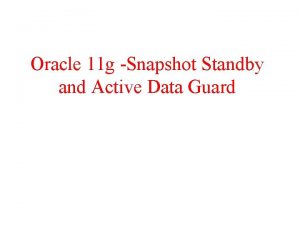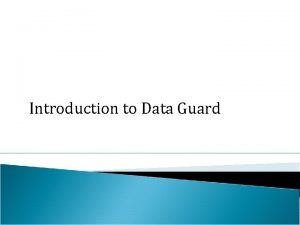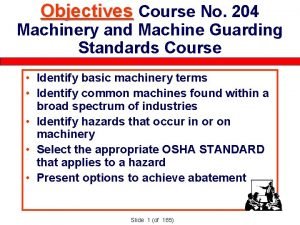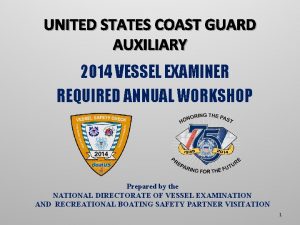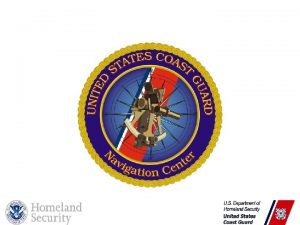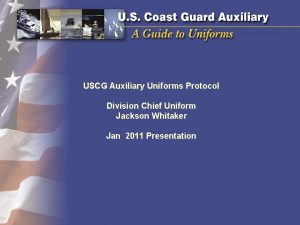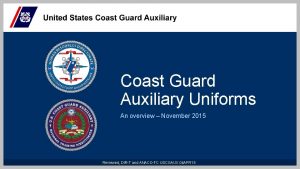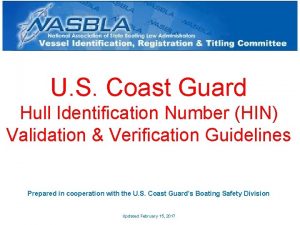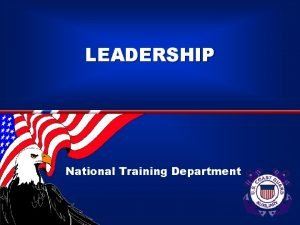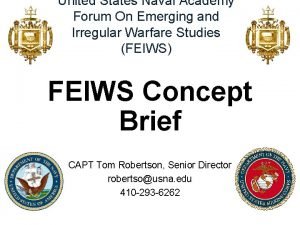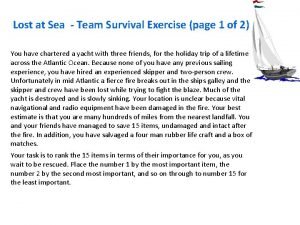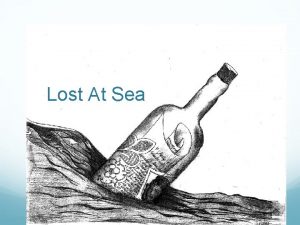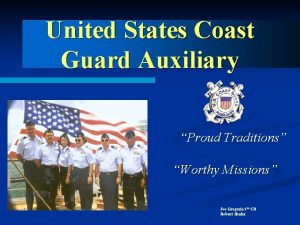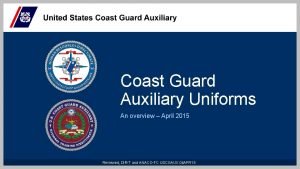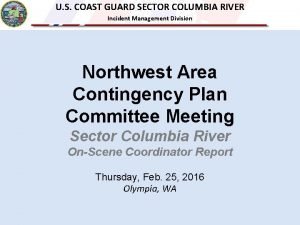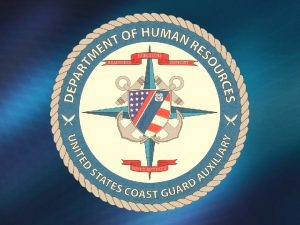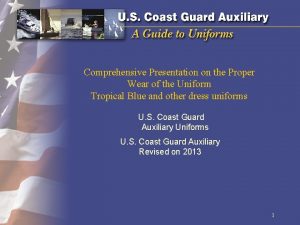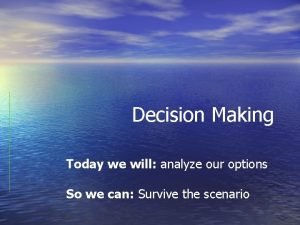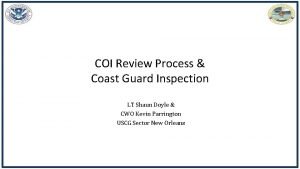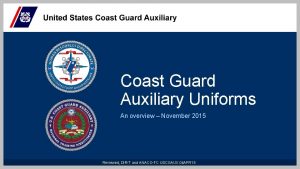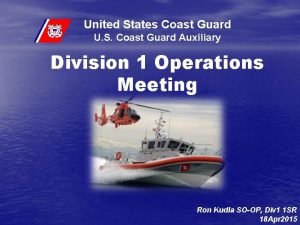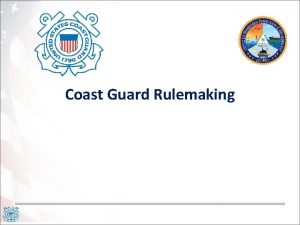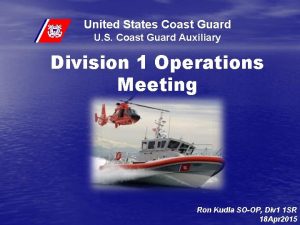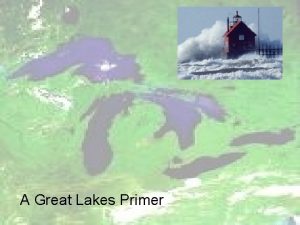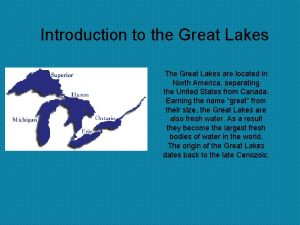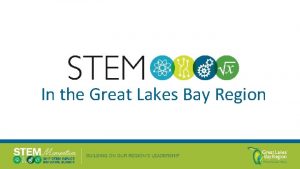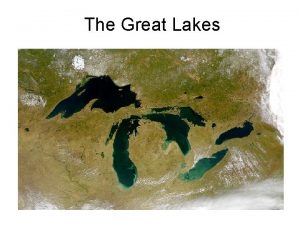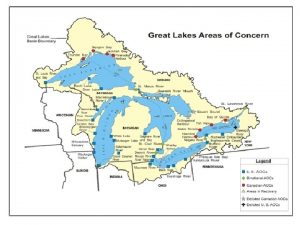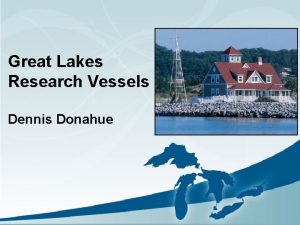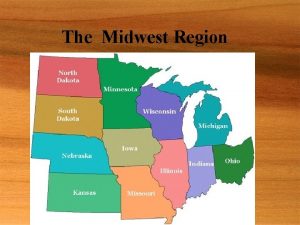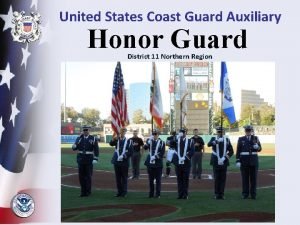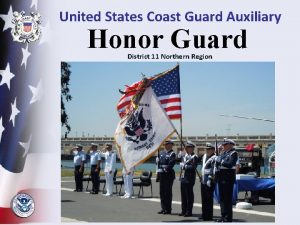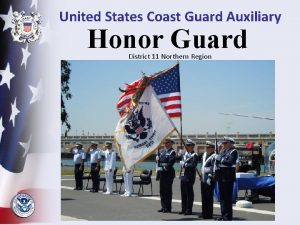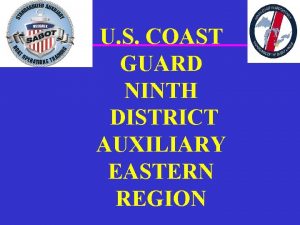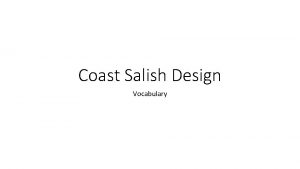Coast Guard Eastern Great Lakes Jeff Platt Lieutenant






















- Slides: 22

Coast Guard Eastern Great Lakes Jeff Platt Lieutenant, U. S. Coast Guard Command Center Chief Sector Buffalo, New York

Coast Guard Missions �Search & Rescue �Ports, waterways & coastal security �Drug interdiction �Living marine resources �Marine safety �Defense readiness �Migrant interdiction �Marine environmental protection �Ice operations �Other law enforcement

Coast Guard Command Center �The PSAP for the Coast Guard � 4 person live watch 24/7/365. �Maintains listening watch for VHF-16 (156. 8 MHz) via radio towers. �Specially trained search and rescue planners. �Can coordinate air support. �Can authorize use of CG VHF working frequencies for operational uses.




Rescue-21 11

Lines of Bearing (LOB) 12

Range Ring Analysis 13

Lines of Bearing (LOB) Search Area 14

Before and After Comparison Before Rescue 21: • Search Area: 950 sq. miles • Assets: One helicopter • Hours: 1. 5 -hour search plus transit time • Cost: $39, 000 After Rescue 21: • Search Area: 15 sq miles. • Assets: One boat • Hours: 30 -minute search plus transit time • Cost: $3, 400 15

The Importance of a 911 Partnership �Despite advances in marine VHF radio systems, boaters are using cell phones primarily �Nationwide, since 2008: 40% cell phone vs. 22% VHF radio �Great Lakes, since 2008: 52% cell phone vs. 25% VHF radio �Most boaters call 9 -1 -1 vice Coast Guard directly �WPH 2 Cellular X/Y data is crucial �Coordinate other responders

Key Information to Collect “The Big Four” �Position of vessel �Coordinates (X/Y), GPS, geographic reference, distance from shore �Nature of distress �Sinking/taking on water, person in the water, aground, fire, medical emergency, collision �Description of vessel �Type (i. e. sailboat), hull color, name, distinguishing features �Number of persons on-board �Adults, children, pets, any disabilities


Non-Distress Situations �Non-emergency or not life-threatening �Out of gas �Disabled (engine, propeller, etc. ) �Aground (not sinking, not taking on water) �Disoriented �CG follows specific policy for responding

Maritime SAR Assistance Policy �Enacted in 1982 by Congress �Determined to be non-distress �“…review Coast Guard policies and procedures for towing and salvage of disabled vessels in order to further minimize the possibility of Coast Guard competition or interference with. . . commercial enterprise. ” �Coast Guard includes active duty, reserve, and auxiliary.

Maritime SAR Assistance Policy • Maritime Assistance Request Broadcast (MARB) – 10 minutes to respond – On scene within a reasonable time (usually one hour or less) – The Coast Guard supports and encourages efforts of private enterprise and volunteerism to assist mariners. Coast Guard resources will not unnecessarily interfere with private enterprise.

Coast Guard Mobile App • Intended Audience: Recreational Boating Public • Distribution: Free download (Android & i. OS) • Status: Final Testing / Approvals • Rollout: “Safe Boating Week 2015”

Resources for the Recreational Boater 1. State Boating Information (State and Local Info & Requirements) - Links to state websites 2. Request Safety Check (Vessel Safety Check by the CG Auxiliary) - Emails the request form data to the CG Auxiliary 3. Review Safety Equipment - Required and Optional Safety Equipment & Checks 4. File Float Plan - Emails float plan to up to three responsible individuals 5. Navigation “Rules of the Road” - Excerpts from the rules and links 6. NOAA Buoys - Displays current conditions from the nearest NOAA buoy 7. Report Hazard (Coast Guard Navigation Center) - Location based reporting with attached geo-coded image 8. Report Pollution (National Response Center) - “Call in a Report” button, dials the NRC 9. Report Suspicious Activity (America’s Waterway Watch) - “Call in a Report” button, dials the NRC 10. Emergency Assistance Button - Dials the nearest CG Sector based on the phone’s current location.

Sector Specifics • Does not replace established comms procedures. • Tool to enhance recreational boater safety. Not a tool for commercial operators. • Displays Warning to user if outside cell-coverage. • Dials nearest CG Sector “As the Crow Flies” • Will not dial outside of the US (International Call) • Public Affairs Guidance (PAG) will be forwarded ahead of the app release to the public.

NG 9 -1 -1 Implementation: The Way Forward What needs to happen to enable CG to get 9 -1 -1 data into the CG-IT Cloud? • Coast Guard needs to be on the National Emergency Number • • • Association (NENA) Standards Committee On a state-by-state basis, CG needs to work with the State on an agreement regarding how NG 9 -1 -1 data will be handled/transferred safely/securely A metadata/VOIP ingest point needs to be identified A way to process and prioritize incoming metadata/VOIP needs to be developed Sprint III will address this issue specifically An auto-routing process/infrastructure needs to be established Watch-standers need training

Points of Contact • LT Jeff Platt, Sector Buffalo (PA/NY border to Ogdensburg, NY) • (716) 843 -9312 • Jeffrey. R. Platt@uscg. mil • (LT Jeff Young after June 19 th, Jeffrey. A. Young@uscg. mil) • CDR Aurora Fleming, Sector New York (NYC, Hudson River) • (718) 354 -4188 • Aurora. I. Fleming@uscg. mil • LT Shannon Smith, Sector Long Island Sound (Long Island) • (203) 468 -4568 • Shannon. F. Smith@uscg. mil
 Difference between data guard and active data guard
Difference between data guard and active data guard Oracle coast guard
Oracle coast guard Upper hood guard and full diameter saw guard
Upper hood guard and full diameter saw guard Upper hood guard and full diameter saw guard
Upper hood guard and full diameter saw guard Vessel examiner test answers
Vessel examiner test answers Us coast guard navigation center
Us coast guard navigation center Coast guard culinary school
Coast guard culinary school Protocol uniforms
Protocol uniforms Uscgaux uniforms
Uscgaux uniforms Secondary hin location
Secondary hin location Coast guard leadership competencies
Coast guard leadership competencies Coast guard academy forum
Coast guard academy forum Lost at sea exercise scenario
Lost at sea exercise scenario Lost at sea ranking chart answer key
Lost at sea ranking chart answer key Procurement process redesign
Procurement process redesign Coast guard sato travel
Coast guard sato travel Coast guard auxiliary uniform
Coast guard auxiliary uniform Coast guard sector columbia river
Coast guard sector columbia river Auxiliary benefits
Auxiliary benefits Undress uniform procurement
Undress uniform procurement Searanking
Searanking Uscg coi inspection checklist
Uscg coi inspection checklist Cgaux uniforms
Cgaux uniforms
